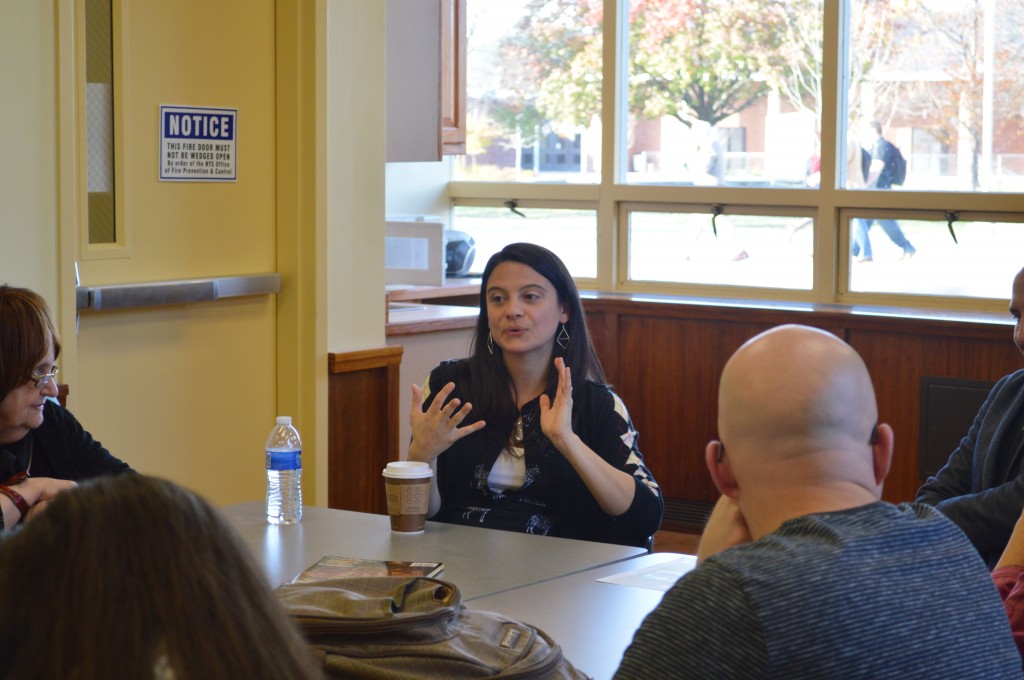
“My soul wasn’t fulfilled,”said Maria Gagliano, a senior editor at Penguin Group, when asked why she had started Slice magazine.
On Monday in Library North, Gagliano gave advice to writers on how to get published in literary magazines, and spoke about her experience running her own publication.
When the Brooklyn-based literary magazine was founded in 2007, it was going to feature “slices,” or excerpts, from novels. But it didn’t work out. “[It] logistically wouldn’t have worked,” Gagliano said. Instead, Slice is a literary magazine that hones in on specific themes — like growing up and escape — around which articles and interviews center. However, the poetry and fiction published in Slice aren’t bound by thematic content.
Slice prides itself in featuring “emerging writers.” The term “emerging” is almost daunting. It implies an eventual or approaching success, which might intimidate young writers who feel as though they have not begun to emerge. But Gagliano defines the term more gently — as someone who hasn’t yet been published, or who has been published only a few times.
Alexi Zentner, short story writer, novelist and English professor, talked about the submission and publishing process.
“Everybody sends out their work too early and before they’re ready,” Zentner said. “A couple years later, you’ll revise and realize the work wasn’t there yet. When your work is done and ready, people will fight over who can publish you.”
The world of literary magazines isn’t exactly a cash cow. Those types of publications usually have only a few thousand subscribers — if they’re lucky.
“I essentially run Slice as a volunteer,” Gagliano said. “I never made money. A literary magazine cannot sustain itself. You won’t make money just by selling magazines. For the longest time we couldn’t pay our writers, we’d give them an issue of the magazine. We now do pay our writers! $100 a story and $25 a poem … Funding is really hard. We’ve done everything from selling cupcakes on our stoop in Brooklyn to renting out Housing Works for a literary trivia fundraiser.”
Despite the small audiences and payments, literary magazines still hold a prestigious and essential place in publishing. Many major writers start off with short stories before booking a deal for a novel at a publishing house. So when Gagliano described the reviewing process for submissions, hopeful young writers leaned forward in their seats.
“For Slice, we don’t even want a cover letter,” Gagliano said. She doesn’t want to be influenced by a writer’s track record with other magazines, instead preferring to focus on the work itself. Before the two co-founders and the editor-in-chief read the work, it goes through “10 to 15 readers” who review submissions only during designated reading periods.
Gagliano stressed the importance of reading submission guidelines before submitting work to Slice or any other publication. Slice receives 5,000 submissions annually, and keeps tracks of that work by accepting submissions not through email, but only through Submittable, a software program meant to manage them.
Gagliano told writers to know what the publications they’re submitting to are looking for, so that they don’t waste the editors’ time, or their own.
“For Slice, we tend to not like genre fiction, but it really depends on the taste of who is reviewing your work,” Gagliano said when asked what Slice isn’t interested in. “We love experimental genres. If you create something great it’s really about doing your own research and finding a home for your submission.”
To close the event, Gagliano leveled with the crowd.
“Perspective is a very big deal,” she said. “Publishing isn’t pretty, and you don’t make money. You have to hustle. Hustling is a big deal and of course, loving books.”


